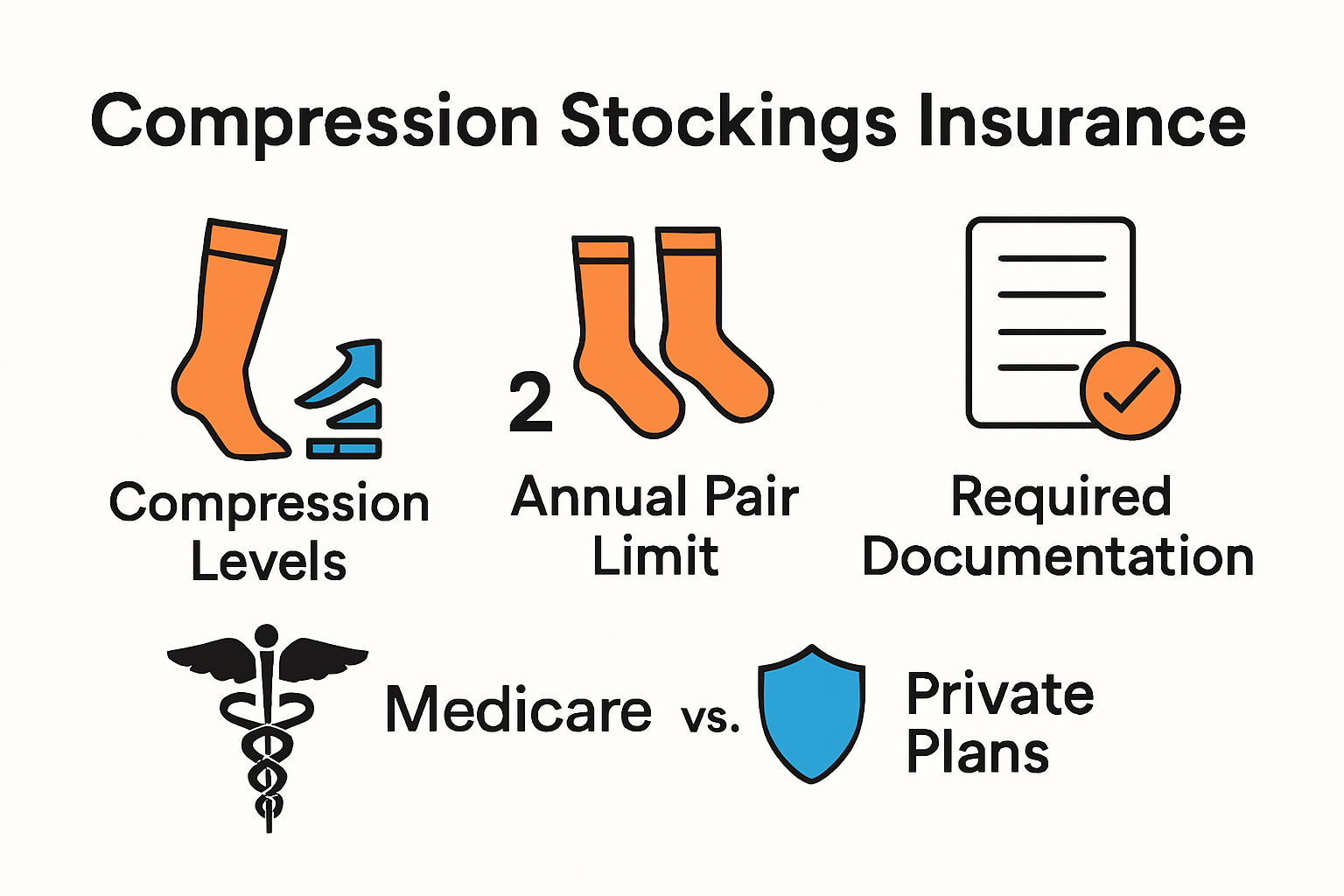
Does Insurance Cover Compression Stockings? What You Should Know 2025
Share

Trying to get insurance to pay for compression stockings can feel like navigating a maze. Some providers will only cover them if you meet strict medical criteria and have documentation that matches their requirements. But the surprise is that Medicare and many private insurers deny coverage to the majority of applicants because they lack specific details in their prescriptions and diagnosis paperwork. What most people miss is that small tweaks to how you document and communicate with your insurer could actually open the door to getting your compression stockings paid for.
Table of Contents
- How Insurance Coverage For Compression Stockings Works
- Eligibility Requirements And Prescription Guidelines
- Common Insurance Plans And What They Include
- Tips For Getting Compression Stockings Covered
Quick Summary
| Takeaway | Explanation |
|---|---|
| Medical necessity is essential for coverage | Insurance companies require proof of a medical condition to justify compression stocking coverage. |
| Document everything thoroughly | Patients must maintain comprehensive medical records, including detailed prescriptions and treatment history, to enhance approval chances. |
| Understand your insurance plan limitations | Different insurance providers have varying coverage rules and restrictions, which must be clarified prior to obtaining stockings. |
| Proactive communication boosts success | Engage with insurance representatives to clarify coverage details and requirements, advocating for necessary support. |
| Prescriptions should include specifics | Ensure your healthcare provider supplies a prescription that outlines the diagnosis and compression level needed for effective treatment. |
How Insurance Coverage for Compression Stockings Works
Compression stockings represent a critical medical intervention for many patients with circulatory conditions. Understanding how insurance coverage works can significantly impact your ability to access these essential medical garments.
Medical Necessity Determines Coverage
Insurance companies typically view compression stockings through a specific lens of medical necessity. Research from the National Institutes of Health reveals that coverage is not automatic but depends on several key factors. Patients must provide comprehensive documentation demonstrating a legitimate medical need. This often requires a detailed physician’s prescription explicitly outlining the specific diagnosis requiring compression therapy.
Common medical conditions that frequently qualify for insurance coverage include:
- Chronic Venous Insufficiency: A condition where leg veins struggle to send blood back to the heart
- Lymphedema: Significant swelling caused by lymphatic system blockages
- Post Surgical Recovery: Preventing blood clots after certain medical procedures
- Diabetic Circulation Issues: Managing potential complications related to reduced blood flow
Navigating Insurance Documentation Requirements
According to a comprehensive JAMA article, insurance providers impose strict documentation requirements for compression stocking coverage. Patients must typically submit:
- Detailed medical records documenting the specific condition
- Physician’s prescription specifying compression level and medical rationale
- Proof that conservative treatments have been attempted or considered
- Documentation demonstrating potential medical risks without intervention
The documentation process can feel complex, but it serves a critical purpose. Insurance companies want to ensure that compression stockings are genuinely medically necessary and not simply a convenience purchase.
Understanding Coverage Limitations

Even when a patient meets initial medical necessity criteria, insurance coverage for compression stockings is not unlimited. Most plans have specific restrictions. Some insurers will cover only certain compression levels, while others limit the number of pairs per year. Medicare and private insurance plans often have different guidelines.
Patients should proactively contact their insurance provider to understand:
- Specific documentation requirements
- Approved compression levels
- Annual quantity limitations
- Reimbursement processes
- In network versus out of network coverage
For those seeking more comprehensive guidance on finding the right compression solution, read our detailed fitting guide to understand sizing and medical considerations.
Remember that while the process might seem complicated, proper documentation and understanding your specific insurance plan can make accessing medically necessary compression stockings much more straightforward.
Here’s a comparison table to help readers understand how Medicare, private insurance, and supplemental insurance differ in coverage characteristics for compression stockings.
| Insurance Type | Requirements for Coverage | Coverage Limitations | Notable Features |
|---|---|---|---|
| Medicare | Physician prescription, diagnosed medical necessity | Limited pairs/year, certain compression only | Strict criteria; usually covers lymphedema |
| Private Insurance | Varies by plan, medical documentation often needed | May vary widely, pre-authorization may apply | Employer/group plans more flexible |
| Supplemental Insurance | Proof of gaps in primary coverage, medical documentation | Fills in where primary plan doesn’t pay | Reduces out-of-pocket costs |
Eligibility Requirements and Prescription Guidelines
Obtaining compression stockings through insurance requires meeting specific eligibility criteria and following precise prescription guidelines. Understanding these requirements can help patients navigate the complex process of medical garment coverage.
Medical Conditions Qualifying for Coverage
According to Medicare guidelines, not all patients automatically qualify for compression stocking coverage. Specific medical diagnoses play a crucial role in determining eligibility. Conditions that typically meet insurance requirements include:
- Chronic Venous Insufficiency: Documented impairment of blood return from leg veins
- Lymphedema: Significant soft tissue swelling requiring consistent management
- Post Surgical Recovery: Prevention of deep vein thrombosis and blood clot risks
- Diabetic Peripheral Neuropathy: Circulation complications requiring specialized support
Patients must have a clear medical diagnosis documented by a licensed healthcare professional. Research from clinical consensus statements emphasizes that medical documentation must explicitly demonstrate the therapeutic need for compression therapy.
Prescription and Documentation Requirements
Medicare coverage guidelines outline stringent prescription requirements for compression garments. A comprehensive prescription must include:
- Specific diagnosis code
- Precise compression level recommendation (measured in mmHg)
- Expected duration of treatment
- Patient’s specific anatomical measurements
- Healthcare provider’s detailed clinical rationale
The prescription serves as a critical bridge between medical necessity and insurance approval. Healthcare providers must demonstrate that compression stockings are not merely a preventative measure but a crucial intervention for managing specific medical conditions.
Professional Evaluation and Ongoing Documentation
Insurance providers require more than a single prescription. Ongoing medical documentation becomes essential for continued coverage. Patients should expect:
- Regular medical assessments documenting treatment progress
- Updated prescriptions typically every 6 to 12 months
- Evidence of compression therapy’s effectiveness in managing the underlying condition
For individuals seeking additional guidance on finding the right compression solution tailored to their medical needs, explore our comprehensive fitting guide to understand sizing and medical considerations.
Navigation of insurance eligibility for compression stockings demands patience, thorough documentation, and close collaboration between patients and healthcare providers. By understanding these guidelines, patients can more effectively access the medical support they require.
To help clarify which medical conditions often qualify for insurance coverage of compression stockings, here’s a quick summary table.
| Medical Condition | Why Compression Stockings Are Needed |
|---|---|
| Chronic Venous Insufficiency | Helps blood flow return from leg veins |
| Lymphedema | Reduces swelling caused by lymphatic blockages |
| Post Surgical Recovery | Prevents blood clots after medical procedures |
| Diabetic Peripheral Neuropathy | Supports circulation and reduces complications |
Common Insurance Plans and What They Include
Compression stockings coverage varies significantly across different insurance plans. Understanding the nuances of each insurance type can help patients navigate their potential reimbursement and coverage options more effectively.
Medicare Coverage Landscape
Medicare Part B provides specific guidelines for compression garment coverage. The program typically covers compression stockings for patients with documented medical conditions such as lymphedema and chronic venous insufficiency. Research indicates that coverage is not universal and depends on strict medical necessity criteria.
Key Medicare coverage characteristics include:
- Coverage limited to medically diagnosed conditions
- Requirement for physician prescription
- Specific documentation of medical necessity
- Limitations on frequency of replacement
- Coverage typically restricted to specific compression levels
Private Insurance Variability
Private insurance plans demonstrate significant variation in compression stocking coverage. Unlike Medicare, private insurers have more flexible but often complex reimbursement structures. A clinical study published in PubMed suggests that compression stockings can be cost-saving interventions, which might influence insurance company policies.
Typical private insurance considerations include:
- Employer-Sponsored Plans: Often have more comprehensive coverage for medical compression garments
- Individual Health Plans: May require additional documentation and have more restrictive guidelines
- Health Maintenance Organizations (HMOs): Usually require referrals and pre-authorization
- Preferred Provider Organizations (PPOs): Generally offer more flexibility in provider selection
Supplemental Insurance and Additional Coverage Options
Patients with complex medical needs might benefit from supplemental insurance plans that provide additional coverage for compression stockings. These plans can help bridge gaps in primary insurance coverage and reduce out-of-pocket expenses.
Strategies for maximizing compression stocking coverage include:
- Thoroughly documenting medical necessity
- Working closely with healthcare providers
- Understanding specific plan details
- Exploring supplemental insurance options
For individuals seeking personalized guidance on finding the right compression solution for their specific medical needs, check out our comprehensive fitting guide to understand sizing and medical considerations.
Navigation of insurance coverage for compression stockings requires patience, detailed documentation, and a proactive approach. By understanding the nuances of different insurance plans, patients can more effectively access the medical support they require.
Tips for Getting Compression Stockings Covered
Navigating insurance coverage for compression stockings can be challenging. Patients must approach the process strategically to maximize their chances of successful reimbursement and coverage.
Comprehensive Medical Documentation
Medicare guidelines emphasize the critical importance of thorough medical documentation. Successful insurance claims for compression stockings require patients to compile a comprehensive medical record that clearly demonstrates medical necessity.
Key documentation strategies include:
- Obtaining a detailed physician’s prescription specifying exact medical condition
- Providing comprehensive medical history related to circulatory issues
- Including diagnostic test results supporting medical necessity
- Documenting previous treatments and their outcomes
- Securing detailed clinical notes explaining why compression therapy is essential
Healthcare providers play a crucial role in this process. They must craft documentation that explicitly connects the patient’s medical condition to the therapeutic need for compression stockings.
Strategic Insurance Communication
Research published in the Journal of Vascular Surgery highlights that proactive communication with insurance providers can significantly improve coverage outcomes. Patients should adopt a methodical approach when interacting with their insurance company.
Effective communication tactics include:
- Requesting a detailed explanation of compression stocking coverage
- Understanding specific documentation requirements
- Asking about pre-authorization processes
- Documenting all communication with insurance representatives
- Obtaining written confirmation of coverage guidelines
Patients should be prepared to advocate for themselves, presenting clear medical evidence and maintaining persistent communication with their insurance provider.
Additional Coverage Optimization Strategies
Maximizing insurance coverage requires a multifaceted approach. Patients can enhance their chances of successful reimbursement by implementing several strategic techniques:
- Verify in-network providers and medical supply companies
- Explore supplemental insurance options
- Consider flexible spending accounts (FSAs) or health savings accounts (HSAs)
- Request detailed billing codes from healthcare providers
- Understand appeal processes for denied claims
For those seeking more detailed guidance on selecting the right compression solution, explore our comprehensive compression stocking selection guide to understand nuanced sizing and medical considerations.
Successful navigation of compression stocking insurance coverage demands patience, meticulous documentation, and a proactive approach. By understanding insurance processes and preparing comprehensive medical documentation, patients can significantly improve their chances of obtaining necessary compression therapy coverage.

Frequently Asked Questions
Does insurance cover compression stockings?
Insurance coverage for compression stockings varies by provider and plan. Many insurers, including Medicare, require documentation of medical necessity, such as a physician’s prescription and specific diagnosis, to qualify for coverage.
What conditions qualify for insurance coverage of compression stockings?
Conditions like chronic venous insufficiency, lymphedema, post-surgical recovery, and diabetic circulation issues often qualify for coverage. Detailed documentation from a healthcare provider is crucial to demonstrate the medical necessity of compression stockings.
How can I improve my chances of getting compression stockings covered by insurance?
To enhance your chances, ensure comprehensive documentation, including a detailed physician’s prescription, medical history, and evidence of previous treatments. Proactive communication with your insurance provider about their requirements is also helpful.
Are there limitations on the number of compression stockings covered by insurance?
Yes, there are often limitations on the number of compression stockings covered per year, as well as specific approved compression levels. Patients should check with their insurance provider to understand these restrictions.
Finding Compression Stockings That Fit Your Diagnosis – and Your Life
Getting insurance to cover compression stockings can be frustrating. The article showed how documentation, specific compression levels, and proof of medical necessity are critical for approval. Many people give up after hitting roadblocks with insurance paperwork or when their plan only covers certain options. But your need for effective, comfortable compression does not disappear just because the process is complicated.
At Fit Stockings, we help you take the next step. Our Jobst collection features medical-grade stockings in multiple compression strengths and styles, all designed for conditions like varicose veins, lymphedema, or post-surgical recovery. Our expert guides and sizing support make it easier to choose the right product, even if your insurance is limited or you want a trusted source. Do not let paperwork stand between you and better leg health. Visit Fit Stockings today to find solutions tailored to your specific diagnosis and everyday needs.
Recommended
- Compression Stockings and Diabetes: What to Know in 2025 – Fit Stockings
- Compression Stockings Fitting Guide 2025: Find the Perfect Fit – Fit Stockings
- The Ultimate Guide to Compression Stockings: Comfort, Health, and Styl – Fit Stockings
- How to Choose Compression Socks: A Helpful Guide for 2025 – Fit Stockings
- Choosing Dental Insurance in Edmonton: A 2025 Guide for All Needs - Unity Square Dental
- Can You Get Insurance on a Rebuilt Title Car?

